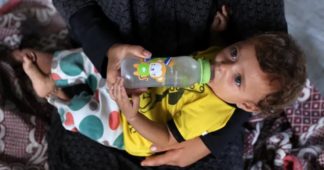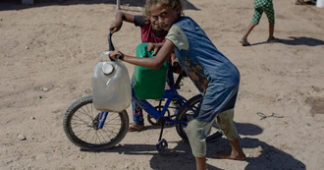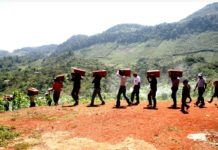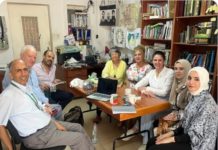Yarden Michaeli and Nir Hasson
Aug 21, 2025
In recent weeks we spoke by video with doctors around the Gaza Strip. Through virtual tours of medical facilities, we sought to document the situation in which thousands of children suffer from severe acute malnutrition. What we saw was of catastrophic proportions

Bayan Saqer is lying on a bed. Her mother is supporting her, holding her head. She’s 10, very thin, frail and weak. Her body is limp. She weighs 17 kilograms (37 pounds).
“That’s the weight of a 4-year-old,” says Dr. Ahmed al-Farra, director of the pediatric department in Nasser Hospital in Khan Yunis, in the Gaza Strip. “She’s not suffering from any disease, only malnutrition.” Two months ago she weighed 24 kilograms, the girl’s mother says.
Dr. al-Farra shows Bayan’s protruding ribs, her scrawny hands. She squeezes his hand and manages to sit up during the examination, but her eyes are lifeless. He asks her to say something; she has to make an effort to say her name. During our conversation it emerges that the father of the family was wounded at the start of the war and lost a leg. Obtaining food became an impossible task.
- An IDF investigation rejected the Gaza famine, but experts say it only reaffirmed it
- ‘No hunger in Gaza,’ say Netanyahu, the Israeli army and media – as starvation worsens
- Famine by design: How Israel ignored warnings over hunger and starved Gaza
“There is no food,” the mother says, “and even if there is, we have no money to buy it.”
We held a virtual encounter with Al-Farra and his patients this past Monday via a video call. In the past few weeks, we’ve sought to document what starvation looks like in Gaza, to witness the gravity of the situation with our own eyes. Israel doesn’t allow journalists into the Strip, but via video we’ve been able to conduct real-time, online tours of hospitals and clinics.
For this article we conducted four such tours, in different places, and conducted separate conversations with another 12 doctors, 10 of them volunteers from the United States and Britain, who are currently in the Gaza Strip or were there recently. What we saw there left no room for doubt about the scale of the horror.
The tour of Nasser Hospital, in the southern part of Gaza, lasted about an hour. Al-Farra went from bed to bed, while another member of the hospital staff held the camera. We saw children whose bodies were blighted by hunger, with bones jutting out. Their hair had turned yellow or fallen out, their faces were wrinkled and their abdomens bloated. Their bodies were limp; many had marks on their skin. Some looked totally apathetic.
By means of this and our other video tours, as well as in the conversations with physicians and members of humanitarian organizations, we were able to document the current condition – and, when possible, the medical history – of some 50 children (and a few adults) who are suffering from severe acute malnutrition.
With respect to about half of them, it was impossible to obtain reliable information, because of the chaos that reigns in the Strip. In the case of 27 children, however, our conversations with doctors, family members and staff working at several official bodies in Gaza revealed a clearer picture: Seventeen youngsters had deteriorated into a state of severe malnutrition without preexisting health conditions; 10 suffered from previous illnesses.
This is the place to say two things about preexisting health conditions. First, we found that the medical ailments we encountered were a result of the catastrophic living conditions in the Strip during the last 22 months, or they had become aggravated acutely because of hunger. Second, the physicians we spoke to repeatedly clarified that even with respect to people who are already ill, severe acute malnutrition is not inevitable.
Based on our conversations, a simple fact emerged: Anyone who claims that the images of starvation in the Gaza Strip are a result of acute genetic or other diseases, and not due to a grave shortage of food, are lying to themselves.
Most of the photographs that accompany this article were taken at our request, some of them during the virtual tours or about the same time. Others were taken by authorized sources affiliated with international aid organizations. A further batch was taken by doctors themselves in a manner that preserved precise time- and GPS-related data. Haaretz examined the information accompanying the images in order to substantiate their reliability.

1. A boy photographed at the Patient Friends Association Hospital by a UNICEF volunteer. 2. Sham Qadeeh, 2, weighs 4.4 kilograms. Suffers from a metabolic disease that requires special nutrition, which isn’t readily available in the Strip. Photographed a week ago at Nasser Hospital in Khan Yunis. 3. A girl photographed at the end of July at the Patient Friends Association Hospital by a UNICEF representative.
Our investigative report seeks to put faces to the people behind the data, as of today: more than 270 dead from starvation; some 2,000 people shot to death while trying to obtain food; thousands of children under the age of 5 suffering from severe acute malnutrition; tens of thousands of children in the same age group suffering from acute malnutrition; and more than half a million people who are forced to endure entire days without eating.
“The starvation is everywhere – it’s everyone,” says Dr. Travis Melin, an anesthesiologist from the United States who is currently working as a volunteer in Nasser Hospital. “When I put someone to sleep for surgery this is very apparent as they are naked and asleep. It is easy to count ribs from across the room, you can see a clear pelvic bone, peripheral blood vessels are very visible as is the small amount of muscle left, as there is no longer fat obscuring these structures. I was in Gaza also a year ago, and all the people I met now were dramatically thinner, almost unrecognizable. We are now very late in this process.”
* * *
Back at Nasser, we see Asil Hamad who, when born three months ago, weighed 3.5 kilos (7.7 pounds). Since then she has only gained 400 grams (14 ounces). Hamad wasn’t diagnosed with an illness. From her mother’s account, the reason for her low weight is clear: “I had tried to breastfeed, but I was also starving.
Dr. al-Farra explains that the mother had wanted to buy formula, but the prices were sky high. One salesman demanded no less than $100 for a tin.
Al-Farra asks the hospital worker accompanying him to point the camera at little Asil. Her gauntness is undeniable; her eyes look large relative to her face, her skin is yellow and her head is covered with scraggly hair dotted with bald spots. The doctor shows us the protruding ribs, the spindly legs and bloated stomach under the baby’s clothes. She’s also suffering from an acute skin inflammation: Large red, almost blood-colored, splotches cover her body. Al-Farra explains that the latter condition is due to diarrhea caused by malnutrition and a shortage of diapers, which aggravates the situation.

4. Maryam, 9, photographed a week ago by a UN staff member at Rantisi Hospital. Not known to have preexisting illnesses. 5. Baraa, 3 months old, photographed at the Patient Friends Association Hospital by a UNICEF representative. 6. A baby girl photographed at the end of May at Nasser Hospital by Dr. Graeme Groom, a volunteer doctor from the U.K.
In the bed opposite lies a redhead baby named Amer Issa al-Masri. Except that Amer is not really a redhead. As in many cases we’ve seen, hunger altered his original hair color. He was born five months ago. Weighing 4.6 kilos – an above-average size – he now weighs a mere 4 kilos. Amer is lying limply on his hospital bed, eyes open but totally indifferent to what is going on around him. His limbs are tiny; it seems he’s not capable of moving them.
His mother tells al-Farra that she tried to breastfeed him but didn’t have enough milk. When formula became too expensive, she started to feed him starch dissolved in water.
“It does have calories,” says Dr. Michal Feldon, a senior Israeli pediatrician, “but aside from that, zero nutrition. It has nothing – no vitamins, no proteins, nothing. It’s impossible to recover from five months of a shortage of food at that age. Children who undergo a thing like that – their brain is finished. Even those who survive will suffer from severe retardation.”
Based on our conversations, a simple fact emerged: Anyone who claims that the images of starvation in the Strip are a result of acute genetic or other diseases, and not due to a grave shortage of food, are lying to themselves.
Amer too suffers from acute skin inflammation, and he too has a bloated stomach and protruding ribs. “He doesn’t suffer from any disease other than severe acute malnutrition,” says Dr. al-Farra. He pinches the baby’s skin during the examination, then turns to us: “It’s only the skin over the bones. The body digests the muscles and the fat.”
Another patient in the same room is 9-year-old Sadin al-Najar, also emaciated. Her eyes are sad, her legs are paralyzed, a tracheostomy tube is inserted into her windpipe, providing an opening for inserting a ventilating device, which she doesn’t need as of yet.
The doctors think that Sadin’s paralysis was caused by a polio-like virus, whose source is likely the sewage that flows freely between the sprawling tents of Gaza’s displaced persons. “Before the war there was one case like this a year,” Dr. al-Farra says, “but now there are 100.” For her part, Dr. Feldon explains that there is no inoculation for the virus in question and that if an epidemic breaks out it will probably spread outside the Strip.

7. A boy photographed at the end of May at Nasser Hospital by Dr. Groom. 8. Raad, 55, weighs 50 kilograms. Photographed a week ago at Nasser Hospital by a UN staff member. Suffered from pneumonia. 9. Bayan Saqer, 10, weighs 17 kilograms. Before the war, she weighed 25 kilograms. She was photographed a week ago at Nasser Hospital. Not known to have preexisting illnesses.
Sadin is suffering from severe acute malnutrition. She weighs 20 kilos, about 10 kilos less than she should. While she is being examined, we see the bones of her spine jutting out abnormally; her skin is also splotchy.
Al-Farra relates that he has consulted with physicians from Harvard, who told him that if the virus is actually spreading already, it’s not due only to sanitary conditions, but also to vitamin deficiency and to a weakened immune system stemming from a state of malnutrition.
Before entering the next room, Dr. al-Farra asks the mothers on hand to show us pictures of their children before they began to lose weight. Bayan looks like a healthy child, wearing a shirt bearing the image of a flying unicorn; Asil, with abundant hair, is seen sleeping; and Sadin is a pretty, healthy girl who’s holding a wreath of red flowers.
The camera moves to the next room. Lying in a bed, under a large painting of Maya the Bee, is Sham Qadeeh, a tiny child in a horrible state. She’s 2 years old and weighs only 4.4 kilos. Sham was born a short time before the war broke out, at a normal weight. Now her abdomen is bloated, her matchstick legs are crooked, her bones are sticking out, her skull is visible under the skin, her eyes are glazed over and her teeth have fallen out. She has the face of an elderly person.
Al-Farra recounts that Sham’s father told him they hadn’t been able to find any milk substitute for her. “As you can see, she’s in a miserable situation,” the doctor says. “She’s always crying, she’s always suffering.”

10. A 14-month-old girl suffering from cerebral palsy who also has problems swallowing. Photographed at the end of July at Nasser Hospital by Saira Hussain, a doctor from the U.K. 11. Ayad, 16, was shot while trying to get food at a GHF center and suffers from malnutrition. He was photographed at Nasser Hospital by a UN staff member. Not known to have preexisting illnesses. 12. A baby boy photographed at the end of May at Nasser Hospital by Dr. Groom.
He notes that depression and melancholy are clear, medical symptoms of malnutrition: “If you look at the babies you feel that all of them are sad. Look, look at their faces. They are always irritable, anxious, always crying. When they’re crying, they are crying weakly.”
Sham is suffering from a metabolic illness that affects her digestive tract, but according to Dr. Feldon, a case of acute deterioration like this attests to a severe lack of food. “In Israel, too, there are various illnesses, but we never ever see children in this condition. There is nothing even resembling it.”
Sham’s mother shows us a photograph from the pre-starvation era in the Strip, in which the baby looks healthy and smiling, with glittering eyes. But she is now fighting for her life, Al-Farra stresses. If she doesn’t get medical care outside Gaza soon, she will not survive.
* * *
We returned for another virtual tour of Nasser Hospital a few days later, this time in an internal medicine ward. Our guides were a representative of the United Nations and a local physician. During this visit, three patients were videoed. One was Duah, a 25-year-old woman who weighs 31 kilos (68 pounds). She suffers from Crohn’s disease, a condition that has been greatly aggravated because the special food she needs is unobtainable in Gaza. Duah is wearing several layers of clothing and is wrapped in a blanket. Because of the overload of patients in the ward, she is lying on the floor.
Another patient in the ward is Hamed, a 14-year-old boy who now weighs 30 kilos, after losing 10 kilos. He has no preexisting conditions. We also see Ayad, who’s 16. During one of his attempts to get his hands on food at a distribution center run by the Gaza Humanitarian Foundation, he was shot – a routine occurrence around GHF sites. Formerly considered healthy, he’s suffering from malnutrition and his bones are protruding.
Later during our virtual tour we are introduced to Othman, who was also shot at an aid-distribution center and is paralyzed on his right side, as well as suffering from a serious head wound. His body, too, has been wracked by severe acute malnutrition.

13. A 30-year-old man photographed about a week ago at Nasser Hospital by a UN staff member. 14. An 11-year-old boy photographed at the end of July at Nasser Hospital by Dr. Hussain. Not known to have preexisting illnesses. 15. A boy undergoing an examination at a medical center in the southern Gaza Strip. Photographed this week.
When diagnosed among adults and adolescents, hunger triggers a special sort of alarm: Young children who are still growing and developing are more sensitive to starvation by far, but the appearance of malnutrition among adults likely attests to the intensity of the humanitarian crisis.
Overall, the crisis in the northern part of the Strip appears to be graver than in the southern areas – as becomes clear from conversations with volunteer doctors in a number of places, as well as from documentation that reached Haaretz from Shifa Hospital in Gaza City.
It’s easy to count ribs from across the room, you can see a clear pelvic bone, peripheral blood vessels are visible as is the small amount of muscle left, as there is no fat obscuring these structures.Dr. Travis Melin
Dr. Waqas Ali arrived from Dallas, Texas, to volunteer and is now working in northern Gaza.
“It’s very evident when you look at them, they look emaciated and you could see pretty much their joints being the thickest part of their legs,” he says about the young patients. “Very thin. There’s just skin, there’s no fat. Patients, when you’re talking to them, they start asking for food. There needs to be an influx of food to catch up [with] the shortage.”
“A lot of the people that I treated were very malnourished,” says Dr. Nour Sharaf, an emergency medicine physician who is also from Dallas and volunteered at Shifa, but has since returned home. “I didn’t need the labs to prove it to me, I could sense it just by touching the patients. A lot of the children that I was treating, they looked so malnourished that they looked many years younger than they actually are. So a 15-year-old child to me would look like they were like 10 or 11. That’s not normal.”
Sharaf explains that before travelling to the Strip, she was advised to pack food for herself: “People had told me: Don’t just pack a couple of protein bars, pack enough food to last you for the two weeks that you are there because you will not find food. It was difficult for me to grasp that until I got there and I realized everything was actually 10 times worse than anything I could have ever imagined. I have no preexisting conditions. I’m a very healthy person. I lost 10 pounds in a two-week time period. That’s a lot of weight for an average person to lose in a very short amount of time. If I were there for two years, how much weight would I have lost? These people have been living with these conditions for two years and a lot of them are just very weak.”
Fifteen minutes by car from Shifa is Al-Ahli Arab Hospital. Another resident of Dallas, Dr. Irfan Ali, an anesthesiologist and expert in pain management who is volunteering there, conducted a video call with Haaretz.
“We did surgery on a baby yesterday, only 15 or 16 months old,” he tells us. “It was an injury from shrapnel. He did not lose much blood from the injury. The surprising thing is that that kid, who’s supposedly a healthy kid – his hemoglobin was only 6.1, and the normal hemoglobin at least is around 12. And there’s only one reason for that kid to have a hemoglobin of 6. It’s due to extreme malnutrition.”
This was Ali’s third stint as a volunteer in the Strip.
“What I have seen in the operating room is that these starving kids have no reserves at all,” he says. “These guys decompensate so quickly that you can’t even imagine. You bring someone into the operating room and otherwise they look okay. And then as soon as you start they either lose their oxygen numbers to a very low [level] or their blood pressure drops down very low. And I think the reason is severe acute malnutrition.”

16. Dr. Ahmed al-Farra with Saleh Barbakh, 11 months old, weighing 3.5 kilograms. Photographed at the end of July at Nasser Hospital. Not known to have preexisting illnesses. 17. A boy photographed two weeks ago at Shifa Hospital by Dr. Waqas Ali, a volunteer doctor from the U.S. 18. A boy photographed two weeks ago at Shifa Hospital by Dr. Ali.
* * *
The physicians fighting for the lives of the starving patients in Gaza are working amid a totally decimated health system. Almost all the hospitals have been damaged in attacks during the war, and some have ceased to function. They face a chronic shortage of medication and equipment, they don’t have enough fuel to operate their electric power system and their personnel are buckling under the tremendous load, which is further compounded by mass-casualty events – frequent occurrences in the Strip.
The hospitals are the last line of defense for children (and adults) who are suffering from a serious lack of food. Before ending up there, the youngsters are treated at health stabilization centers, a network of dozens of facilities run by the UN or by other international organizations caring for patients in various stages of malnutrition.
Last Sunday we toured a health center operated by UNWRA, the UN refugee agency, in the Nuseirat refugee camp in central Gaza. During our virtual visit, we counted at least 13 mothers with infants in the waiting room. The babies’ condition was better here than that of their hospitalized counterparts. But even so, signs of malnutrition were evident in some of them: dry, splotchy skin, spindly limbs and thinning hair with signs of baldness.
The equipment and conditions in the center are very basic; in fact, the children aren’t even weighed there. A nurse checks the circumference of their upper arms with a tape measure, a technique common in undeveloped countries. If the result is less than 12 centimeters (4.7 inches), apparently regardless of age, the child enters a stabilization program that includes nutritional food and follow-up appointments.
During our tour we meet Lian, a 7-month-old girl; the circumference of her arm is 11.1 centimeters. This is her fourth visit to the UNWRA facility and her condition is not improving. Her mother relates that her husband was arrested by the Israeli army six months ago and is being held in Ofer Prison, near Ramallah in the West Bank.

19. Mohammed, 3 months old, was photographed at the end of July at the Patient Friends Association Hospital by a UNICEF representative. 20. Huda Abu Najah, 12, photographed this week at Nasser Hospital by a staff doctor. Not known to have preexisting illnesses. 21. Maryam, 2, weighs 5 kilograms. Photographed in early June at Nasser Hospital by a UNICEF representative. Not known to have preexisting illnesses.
“There is no way of feeding all the children as they should be fed. Yesterday I didn’t eat,” she says. “Some good people gave me a cooked meal, but I preferred to give it to my children.”
Abdel Rahman, the next infant to be examined, is in worse condition than others in the health center. He’s extremely thin, his stomach is bloated, his ribs stick out and his hair patchy. Particularly worrisome for the nurses is the fact that this is the second time he’s started treatment to ward off malnutrition.
“He was here a few months ago, received treatment and recovered,” the attending physician explains, adding, “And then he deteriorated again.”
A nurse holds up to the camera the bottle Abdel’s mother brought with her. “It’s herbal tea,” she says. “Zero calories, zero nutrients.” She lays him down and offers him something referred to as therapeutic food – a white-and-red bag that contains a kind of nutritional paste that is also rich in calories, called Plumpy’Nut.
Little Abdel displays determination of a sort we didn’t see among the young patients at hospitals. He grips the little sack tightly and sucks from it intensely. “It looks like he’s fighting for his life,” we note. “Exactly,” the doctor replies.
We also meet Lin and Lian, twin girls of six months, one wearing a pink dress, the other a white one. Their mother has tied bags around their waists, in lieu of diapers – probably the cause of the skin inflammations the girls are suffering from. Their arm measurements indicate that they are suffering from malnutrition, and the nurse packs up some therapeutic food for them.
“I thank God for giving me two girls,” their mother says, “but I can’t find food for them.”

22. A baby boy photographed at the end of May at Nasser Hospital by Dr. Groom. 23. Abdel Rahman, 1, photographed a week ago at the stabilization center in Nuseirat by a UNRWA representative. Has no preexisting conditions. 24. Mohammed. Photographed a week ago at Rantisi Hospital by a UN staff member. Has Down syndrome.
There are some 150 similar health centers treating malnourished youngsters throughout the Strip. In recent months the UN has warned time and again that families are unable to seek care for their offspring at these facilities on a regular basis because of the evacuation orders the Israel Defense Forces issues every few days. Thus, in some cases, the stabilization center itself is located in an area that the inhabitants have been ordered to leave, and sometimes it’s the families who have been forced to leave and find themselves far from the center. One evacuation order, issued on July 20, led to the closure of six centers for treating malnutrition in Deir al-Balah alone.
We conducted our last virtual tour on Monday at a health center run by an international organization in the southern Strip. Parents and children waited their turn and, after the arm measurements were taken, received a weekly ration of Plumpy’Net.
“I arrived a little more than a month ago,” a representative tells us. “I was surprised because of the amount of malnutrition. People were super skinny. Everyone you see was very very skinny. The scarcity of food was affecting everyone. Since they brought in more food, there is a bit of improvement. But people are still desperate.”
Abdel displays determination of a sort we didn’t see among the patients at hospitals. He grips the sack and sucks it intensely. ‘It looks like he’s fighting for his life,’ we note. ‘Exactly,’ the doctor replies.
* * *
Deaths from hunger began to be documented on a daily basis in late July, but tell-tale signs of the looming crisis were there beforehand. In early March, the Israel government announced that it would no longer allow food to enter the Gaza Strip. For more than two and a half months “not a single grain” entered, in the words of Finance Minister and security cabinet member Bezalel Smotrich.
Dr. Victoria Rose, a plastic surgeon from Britain who volunteered in Gaza last summer and returned for another stint in May, experienced the worst of Israel’s policy of deliberate starvation.
“In May, the famine had a huge effect on wound healing,” Rose tells us. “We saw a huge number of simple wound infections just exacerbating at rates that we couldn’t control. Children were unable to heal because they’re not getting the essential nutrients and vitamins they need. All our colleagues lost about 5 to 10 kilos. I didn’t meet anyone that hadn’t lost a significant amount of weight since the last time I saw them. The children themselves look a lot younger than their Western counterparts. A child that you would think was 5 or 6 – you’d find out that they weren’t 8 or 9.”

25. Amer Issa al-Masri, 3 months old, weighs 4 kilograms (born weighing 4.6 kilograms). Photographed at the beginning of the month at Nasser Hospital. 26. Mustafa, shot while trying to get food, photographed at the beginning of the month at Nasser Hospital by a UN staff member. 27. Hamed, 14, weighs 31 kilograms. Photographed a week ago at Nasser Hospital by a UN staff member.
Dr. Tomo Potokar, another plastic surgeon from Britain, was a volunteer in Gaza for a month until early June. During that time he lost 11 kilos.
“You see it on every level. You see it physically,” he says. “You see it psychologically. You see it in the wounds that fail to heal. You see it in people’s tiredness. They’re giving up because they’re just so worn out.”
The starvation operation that started in March was a continuation of a severe crisis that has been evident since the war broke out in 2023, and throughout the following year, when Israeli politicians spoke in favor of “preventing humanitarian aid.” Some explicitly mentioned denying Gazans food and starving them. Indeed, two months after the Hamas massacre on October 7, humanitarian groups warned about a dearth of food. The prices in the markets began to soar, people ate animal food and farmland in the Strip was destroyed.
In January 2024, Haaretz Magazine devoted a cover story to the subject, titled, “Thou shalt not starve others.” A month later, UNICEF, the UN’s emergency fund for children, declared that 90 percent of the children in Gaza below the age of 5 were suffering from food insecurity. Another month passed and the International Court of Justice ordered Israel to allow food to flow into the Strip. The court explained that under Israel’s commitments as a signatory to the international convention to prevent genocide, and against the backdrop of the spread of famine and starvation, it must allow food distribution amid full cooperation with the UN.
Two months later, a request was filed for the International Criminal Court to issue arrest warrants for Prime Minister Benjamin Netanyahu and the defense minister at the time, Yoav Gallant. The first charge cited was using starvation as a method of warfare.
Throughout the past year, repeated warnings have been issued by a host of global organizations and experts. In the meantime, the UN and humanitarian organizations have tried to stave off mass starvation by means of a decentralized network of some 400 distribution centers, bakeries and community kitchens. At its peak the network distributed more than a million hot meals a day, in addition to providing dry foodstuffs to families. At the end of 2024 Israel started to starve the inhabitants of the northern Gaza Strip in order to force them to move southward. Already then, starvation was discernible in other areas, too.

28. A girl photographed two weeks ago at Shifa Hospital by Dr. Ali. 29. Habiba al-Khalani, 6 months old, weighs 3.4 kilograms. She was photographed at the beginning of the month at Nasser Hospital. Being examined for a possible metabolic disorder. 30. Shireen, 13, photographed a week ago at Shifa Hospital by Dr. Ali.
Dr. Mimi Syed, an emergency doctor from Washington state, volunteered at a hospital in central Gaza last December. One day she left Al-Aqsa Hospital, in Deir al-Balah, and documented the children she encountered outside. Syed sent Haaretz a collection of photographs in which children under the age of 7 are seen with clear signs of malnutrition: balding, altered hair color and splotches on their skin.
In early 2025, with a cease-fire in place, relief came to the Gazans as hundreds of food trucks streamed in every day and the warehouses filled up. But two months later, the policy of protracted starvation took effect.
“The decision we made tonight on the total cessation of the entry of humanitarian aid into Gaza is an important step,” Smotrich declared at the time. “Now we need to open the gates of hell on the enemy.”
The gates of hell were indeed opened, and the price was paid, and is continuing to be paid, by the children of Gaza. As early as April, the UN’s food program announced that the last bakery in Gaza had shut down because it had no more flour or cooking gas. Official Israel was not fazed.
Two weeks passed and the rate of children under the age of 5 suffering from acute malnutrition doubled from 2 percent to 4 percent. At the end of April the distribution of dry food was also halted, as supplies in the UN’s warehouses ran out. Even then, Israel continued to adhere to its rigid stance.
It wasn’t until May 19 that the government yielded to international pressure and agreed to soften its starvation campaign. “Israel will send in a basic amount of food,” Prime Minister Benjamin Netanyahu declared, and Smotrich stressed, that “what will enter is the least of the least.”
In late May, Israel and the United States launched a feeding program via a new organization called the Gaza Humanitarian Foundation, a poor idea that immediately turned out to be disastrous. The GHF distributed food at only four centers, three of them in the southern Strip, far from the main population centers. Tens of thousands of people flocked to the sites, en masse.

31. A teenage boy photographed about two weeks ago at Shifa Hospital by Dr. Ali. 32. Sadin al-Najar, 9, weighs 20 kilograms. She contracted an infectious disease and suffers from partial paralysis. Photographed earlier this month at Nasser Hospital.
The IDF started to open fire routinely toward the starving crowds. According to the Gaza Health Ministry, some 2,000 people have been shot to death in proximity to the centers, or while trying to obtain food from trucks that stopped and were looted by swarms of people.
The food itself generally reached the stronger members of the population. The sick, the solitary, women and children found themselves dependent on men who might succeed in bringing them a bit of food. Among those who were not so fortunate, starvation surged.
The situation of the children has only become worse. In June, the rate of acute malnutrition among children stood at 6 percent. The Netanyahu government didn’t blink then or even when the rate of acute malnutrition among children soared to almost 9 percent, according to a comprehensive survey published on July 15.
Five days later, the daily mortality from starvation began in Gaza, and only a few days after that, only under heavy international pressure, did Israel show initial signs of coming to its senses, greatly increasing the entry of aid trucks into the Strip, and allowing airdrops at various locations.
In the meantime, the humanitarian situation has improved a bit and the prices of foodstuffs in the markets have plunged, but Israel’s actions are far from sufficient in countering the plight in Gaza. Indeed, it was Israel that brought about the collapse of the orderly aid-distribution program overseen by the UN and humanitarian organizations, without presenting a decentralized, effective substitute that would reach the weaker population groups.
Foreign Minister Gideon Sa’ar and Diaspora Affairs Minister Amichai Chikli are still sticking spokes in the UN’s wheels and trying to disrupt its work. The office of the Coordinator of Government Operations in the Territories is hindering the movement of the aid trucks. The IDF is piling up various obstacles, both physical and bureaucratic, with the result being that the UN is unable to replenish its warehouses and renew the supply network.
If Israel wants to curb the starvation crisis in the Gaza strip, it has a variety of measures to implement: It can take the necessary actions to renew the UN’s supply network; allow a steady supply of medication and medical equipment into the Strip, while lifting all barriers to the evacuation of seriously ill individuals from Gaza; remove all restrictions on the entry of food by means of humanitarian organizations, donations from Israelis, and via local merchants (a process that has begun in a limited way); allow fishing in a large area off the Gaza coast; permit access to remaining farmland (98 percent of the fields in the Strip have been damaged or are off-limits to inhabitants); initiate a plan for the immediate rehabilitation of the poultry industry (99 percent of all chicken coops have been destroyed); and so on.
In the meantime, deaths from starvation continue to mount – every day.
We remind our readers that publication of articles on our site does not mean that we agree with what is written. Our policy is to publish anything which we consider of interest, so as to assist our readers in forming their opinions. Sometimes we even publish articles with which we totally disagree, since we believe it is important for our readers to be informed on as wide a spectrum of views as possible.











